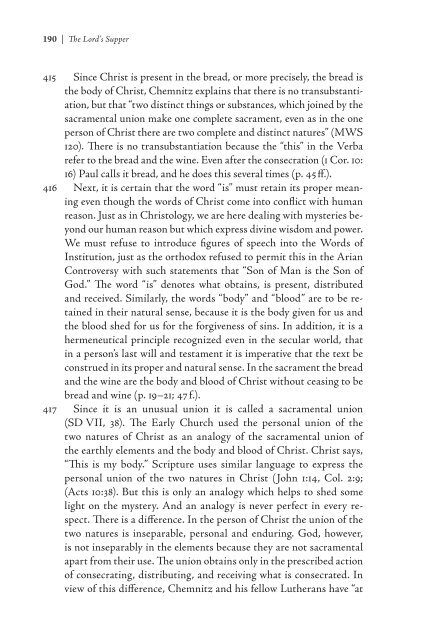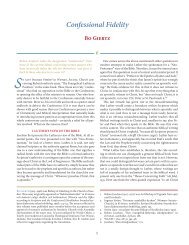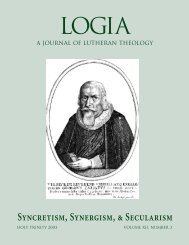The Lord's Supper in the Theology of Martin Chemnitz Bjarne - Logia
The Lord's Supper in the Theology of Martin Chemnitz Bjarne - Logia
The Lord's Supper in the Theology of Martin Chemnitz Bjarne - Logia
Create successful ePaper yourself
Turn your PDF publications into a flip-book with our unique Google optimized e-Paper software.
0 | <strong>The</strong> Lord’s <strong>Supper</strong><br />
415 S<strong>in</strong>ce Christ is present <strong>in</strong> <strong>the</strong> bread, or more precisely, <strong>the</strong> bread is<br />
<strong>the</strong> body <strong>of</strong> Christ, <strong>Chemnitz</strong> expla<strong>in</strong>s that <strong>the</strong>re is no transubstantiation,<br />
but that “two dist<strong>in</strong>ct th<strong>in</strong>gs or substances, which jo<strong>in</strong>ed by <strong>the</strong><br />
sacramental union make one complete sacrament, even as <strong>in</strong> <strong>the</strong> one<br />
person <strong>of</strong> Christ <strong>the</strong>re are two complete and dist<strong>in</strong>ct natures” (MWS<br />
120). <strong>The</strong>re is no transubstantiation because <strong>the</strong> “this” <strong>in</strong> <strong>the</strong> Verba<br />
refer to <strong>the</strong> bread and <strong>the</strong> w<strong>in</strong>e. Even after <strong>the</strong> consecration (1 Cor. 10:<br />
16) Paul calls it bread, and he does this several times (p. 45 ff.).<br />
416 Next, it is certa<strong>in</strong> that <strong>the</strong> word “is” must reta<strong>in</strong> its proper mean<strong>in</strong>g<br />
even though <strong>the</strong> words <strong>of</strong> Christ come <strong>in</strong>to conflict with human<br />
reason. Just as <strong>in</strong> Christology, we are here deal<strong>in</strong>g with mysteries beyond<br />
our human reason but which express div<strong>in</strong>e wisdom and power.<br />
We must refuse to <strong>in</strong>troduce figures <strong>of</strong> speech <strong>in</strong>to <strong>the</strong> Words <strong>of</strong><br />
Institution, just as <strong>the</strong> orthodox refused to permit this <strong>in</strong> <strong>the</strong> Arian<br />
Controversy with such statements that “Son <strong>of</strong> Man is <strong>the</strong> Son <strong>of</strong><br />
God.” <strong>The</strong> word “is” denotes what obta<strong>in</strong>s, is present, distributed<br />
and received. Similarly, <strong>the</strong> words “body” and “blood” are to be reta<strong>in</strong>ed<br />
<strong>in</strong> <strong>the</strong>ir natural sense, because it is <strong>the</strong> body given for us and<br />
<strong>the</strong> blood shed for us for <strong>the</strong> forgiveness <strong>of</strong> s<strong>in</strong>s. In addition, it is a<br />
hermeneutical pr<strong>in</strong>ciple recognized even <strong>in</strong> <strong>the</strong> secular world, that<br />
<strong>in</strong> a person’s last will and testament it is imperative that <strong>the</strong> text be<br />
construed <strong>in</strong> its proper and natural sense. In <strong>the</strong> sacrament <strong>the</strong> bread<br />
and <strong>the</strong> w<strong>in</strong>e are <strong>the</strong> body and blood <strong>of</strong> Christ without ceas<strong>in</strong>g to be<br />
bread and w<strong>in</strong>e (p. 19–21; 47 f.).<br />
417 S<strong>in</strong>ce it is an unusual union it is called a sacramental union<br />
(SD VII, 38). <strong>The</strong> Early Church used <strong>the</strong> personal union <strong>of</strong> <strong>the</strong><br />
two natures <strong>of</strong> Christ as an analogy <strong>of</strong> <strong>the</strong> sacramental union <strong>of</strong><br />
<strong>the</strong> earthly elements and <strong>the</strong> body and blood <strong>of</strong> Christ. Christ says,<br />
“This is my body.” Scripture uses similar language to express <strong>the</strong><br />
personal union <strong>of</strong> <strong>the</strong> two natures <strong>in</strong> Christ (John 1:14, Col. 2:9;<br />
(Acts 10:38). But this is only an analogy which helps to shed some<br />
light on <strong>the</strong> mystery. And an analogy is never perfect <strong>in</strong> every respect.<br />
<strong>The</strong>re is a difference. In <strong>the</strong> person <strong>of</strong> Christ <strong>the</strong> union <strong>of</strong> <strong>the</strong><br />
two natures is <strong>in</strong>separable, personal and endur<strong>in</strong>g. God, however,<br />
is not <strong>in</strong>separably <strong>in</strong> <strong>the</strong> elements because <strong>the</strong>y are not sacramental<br />
apart from <strong>the</strong>ir use. <strong>The</strong> union obta<strong>in</strong>s only <strong>in</strong> <strong>the</strong> prescribed action<br />
<strong>of</strong> consecrat<strong>in</strong>g, distribut<strong>in</strong>g, and receiv<strong>in</strong>g what is consecrated. In<br />
view <strong>of</strong> this difference, <strong>Chemnitz</strong> and his fellow Lu<strong>the</strong>rans have “at




